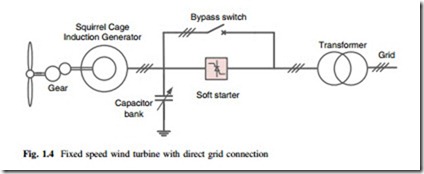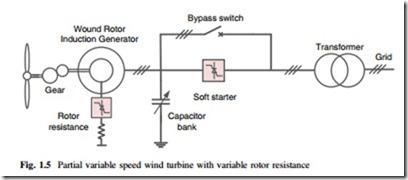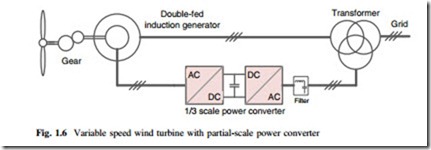Development of Wind Power Technologies
1.2.1 Evolution of Wind Turbine Concepts
The technologies used for Wind Turbine System (WTS) have also changed dramatically for the last 30 years with four to five generations emerged [6–8]. Until now the existed or existing wind turbine configurations can be generally categorized into four concepts [8]. The main differences between these concepts locate on the types of generator, power electronics, speed controllability, and the way in which the aerodynamic power is limited.
A. Fixed Speed Wind Turbines (Type A)
As shown in Fig. 1.4, this configuration corresponds to the so called “Danish concept” that was very popular in 80s. The wind turbine is equipped with
asynchronous Squirrel Cage Induction Generator (SCIG), and smoother grid connection can be achieved by incorporating a soft-starter.
The disadvantages of this early concept are as follows: a reactive power com- pensator (e.g., capacitor bank) is required to compensate the reactive power demand by the asynchronous generator. Because the rotational speed is fixed without any controllability, the mechanical parts must be strong enough to withstand adverse mechanical torque, and the wind speed fluctuations are directly transferred into the electrical power pulsations which could yield to instable output voltage in case of week power grid.
B. Partial Variable Speed Wind Turbine with Variable Rotor Resistance (Type B)
As presented in Fig. 1.5, this concept is also known as OptiSlip (VestasTM) emerged in the mid 1990s [9]. It introduces the variable rotor resistance and thus limited speed controllability of wind turbines. The Wound Rotor Induction Generator (WRIG) and corresponding capacitor compensator are typically used, and the generator is directly connected to the grid by a soft-starter.
A technology improvement of this concept is that the rotational speed of the wind turbine can be partially adjusted by altering the rotor resistance. This feature will contribute to the mechanical stress relief and make a more smooth electrical power output. However, the power loss dissipating constantly in the rotor resistors is a significant drawback for this concept.
C. Variable Speed Wind Turbine with Partial-Scale Power Converter (Type C) This concept is the most established solution nowadays and it has been used since 2000s. As shown in Fig. 1.6, a back-to-back power electronics converter is adopted in conjunction with the Doubly-Fed Induction Generator (DFIG). The stator windings of DFIG are directly connected to the power grid, while the rotor windings are connected to the power grid by the power electronics converter with normally 30 % capacity of the wind turbine [10, 11].
By the use of power electronic converter, the frequency and current in the rotor can be flexibly regulated and thus the variable speed range can be further extended to a satisfactory level. Meanwhile the power converter can partially regulate the
output power of the generator, improving the power quality and providing limited grid support. The smaller converter capacity makes this concept attractive from a cost point of view. However, its main drawbacks are the use of slip rings and the insufficient power controllability in case of grid faults—these disadvantages may comprise the reliability performance and are hard to satisfy the future grid requirements as claimed in [12, 13].
D. Variable Speed Wind Turbine with Full-Scale Power Converter (Type D) Another promising concept that is becoming popular for the newly installed wind turbines is shown in Fig. 1.7. It introduces a full-scale power converter to inter- connect the power grid and stator windings of generator; thus all the generated power by the wind turbine can be regulated. The asynchronous generator, Wound Rotor Synchronous Generator (WRSG), or Permanent Magnet Synchronous Generator (PMSG) have been reported to be used in this concept.
The elimination of slip rings, simpler or even eliminated gearbox, full power and speed controllability as well as better grid support ability are the main advantages of this solution compared to the DFIG-based concept. Thanks to the use of full-scale power converter, the voltage level of the power conversion stage can be rather flexible; in the future the voltage might be high enough to directly connect to the power grid without the bulky low-frequency-transformer, which is an attractive feature for the future wind turbine system. However, more stressed and expensive power electronics are expected and the price for Permanent Magnet (PM) materials may raise some uncertainties for this concept to be further commercialized— leading to the development of generator technology with less or even no PM in the future.
Evolution of Power Electronics for Wind Turbines
Figure 1.3 summarizes the role and capacity changes of power electronics in the wind turbine system. For each of the development stage the corresponding power electronic components are also highlighted in Figs. 1.4, 1.5, 1.6 and 1.7, respectively. In the 1980s, the power electronics for wind turbines is just a soft-starter; only some simple thyristors were applied and they do not need to constantly carry the full power. In the 1990s, the power electronic was mainly used for the rotor resistance control; more advanced diode bridges and semi-controlled thyristors were used to constantly alter the rotor resistance. Since 2000, even more advanced back-to-back power converters were introduced in partial-scale capacity and started to regulate the power in the rotor; the full-controlled devices like IGBT or GCT were applied. Nowadays thanks to the more powerful semiconductor devices, full-scale power converters are adopted to regulate all the generated power by wind turbines; it is possible to be flexible and to fully control the current/voltage in the wind turbine system.
As it can be seen, in the last few decades, power electronics gradually become more and more advanced and bring significant performance improvements for the wind turbine system—not only to reduce the mechanical stress and increase the energy capturing efficiency, but also to enable the whole wind turbine system to act as a controllable generation unit in order to be better integrated with the power grid [6, 7]. With the continuous technology improvement and going down price of power semiconductor devices, it can be predicted that the variable speed wind turbines equipped with full-scale power converter at multi-MW level will be the dominant solution for the next generation wind turbine system.



